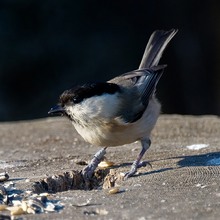

Biodiversity
Action
Plan
Willow Tits feed usually in scrub and the understorey layer. In summer the diet consists largely of invertebrates. In winter they take seeds and sometimes come to feeders.
Willow Tit is the only UK Tit species to excavate a new nest hole each breeding season, the work normally carried out by the female. The nest is positioned less than a metre above the ground in a rotten stump.
Willow Tits can be found in scrubby woodland in wet places: habitats such as wet woodlands, damp woodland margins and scrub on the edges of wetlands. They also favour damp, early successional woodland often found on post-industrial land and old pit tips in Barnsley.
Willow Tits have large territories and their young do not move easily through open landscapes to find new areas, so having enough connected habitat is important. In Barnsley this is often provided by scrub-lined old railways tracks, overgrown hedgerows and other patches of scrub.
RSPB research has identified key habitat features associated with woodlands occupied by Willow Tits compared with those where they have been lost.
Woods that have retained breeding Willow Tits have damp soils, lower tree canopy cover and higher cover in the mid shrub layer, often younger and smaller woodlands with a mix of vegetation heights and more species indicative of scrub and wet woodland such as Willow, Alder, Birch and Elder.
Examples of where Willow Tit can be found in Barnsley include: Old Moor, Edderthorpe, Carlton Marsh, Pool Ings, Wilthorpe Marsh, Barrow and Worsbrough country park. Sites known to support Willow Tit have been included in the Dearne Valley Wetlands SSSI designated in 2021-2. However Willow Tit can also be found in scrubby areas around upland reservoirs.
Status
Willow Tit is a Red List species of conservation concern
Willow Tit is a Local Priority Species highlighted in the Barnsley Biodiversity Plan because of its national status and the opportunity there is in Barnsley to help conserve and expand the existing population.
Willow Tit is included in the UK List of Priority Species for conservation action under the UK Biodiversity Action Plan (UK BAP) in 2007.
Willow Tit is listed as a species of ‘principal importance for the purpose of conserving biodiversity’ under section 41 (England) of the NERC Act (2006) in 2008.
Willow Tits therefore need to be taken into consideration by any public body in managing their estate.
Willow tit, Poecile montanus.
The UK population of Willow Tit has fallen by 94% since the 1970s, the largest drop of any common resident bird, and 50% of their breeding range lost. In much of England, especially in the south and east, Willow Tit has almost disappeared.
Nowhere now a common bird, it is still seen in Barnsley; in ones and twos at a number of sites in the area.
Reasons for decline and loss
One factor may be increased competition for nest sites with other tit species and predation by an increased Great Spotted Woodpecker population; however it is thought that habitat loss is the main reason for the decline of the Willow Tit.
Clearing away of standing deadwood (nest site requirement) and loss of scrub (food source) in woodlands drained to become less damp, are thought to be the main reasons for Willow Tit declines. Natural succession leading to the decline and loss of damp young woodland, plays a part. Their sedentary nature and vulnerability to habitat fragmentation makes the loss of connective habitat more significant.
Good conservation management practice
Habitat management needs to protect and conserve areas of scrub where Willow Tits are present. Maintaining early successional wet woodland and dense damp scrub is key. Conservation management can support Willow Tit by creating or maintaining:
- damp conditions (preventing drying out)
- scrubby areas and dense undergrowth, and scrubby corridors between suitable habitats.
- areas of young growth
- standing deadwood
Standing deadwood for nest sites can be provided by cutting suitable quick rotting trees at about chest height and by logs being tied to trees.
Standard nest boxes are not used by willow tit but boxes set low and filled with wood chips may sometimes be used.

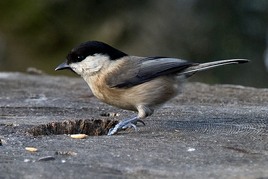
Willow tits are not known to disperse over larger distances, and so once lost from an area they tend not to return.
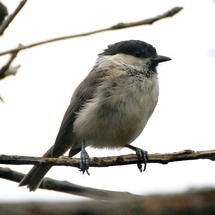
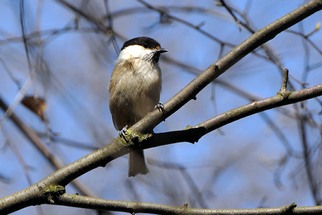
Willow Tits, between the Blue and Great Tit in size, have a bullnecked appearance with white cheeks and a large sooty-black cap extending to the back of the neck.
They are often recognised by their ‘nasal’ call, used in pre-breeding season surveys.
Back from the Brink: Willow Tit
The Back from the Brink (BftB) programme from 2017 2021) aimed to save some of England’s most threatened species from extinction and put them back on the road to recovery.
The BftB Willow Tit project took forward work in the Dearne Valley Green Heart NIA, where surveys resulted in a report published in British Birds.
Thriving Willow Tits in a post-industrial landscape,Carr, G. & Lunn, J. (2017)
Building on this work, the BftB project, led by YWT and RSPB, aimed to gain a better understanding of the habitat characteristics used by Willow Tits and how far they travel between patches. It included
- Annual surveys collected population data and distribution in the NIA,
- Ringing and tracking Willow Tits with use of radio tracking on 11 birds to get data on use of habitats and landscape
- Improved >100ha habitat in land managed by YWT, RSPB, BMBC, EA, YW, …
- Enhancing scrub, understorey and woodland edge to suit Willow Tit.
- Selected thinning and coppicing
- Removing tall canopy trees
- Creating more woodland edge through rides and glades
- Some planting of key scrub species
- Creating linkages between sites .
- Deadwood logs strapped to living trees, and leaving stumps to increase Willow Tit nesting opportunities.
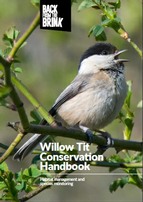
Legacy of the BftB project
for Willow Tit conservation
Willow Tit conservation handbook for habitat management and species monitoring
Text: Geoff Carr and Sophie Pinder.
A landscape management plan to improve habitat for Willow Tit in the Dearne Valley.
Ongoing monitoring, surveying and conservation management for Willow Tit.
SSSI designation of Dearne Valley Wetlands with sites notified for Willow Tit.
Local action:
- Raise awareness of decline of Willow Tits and what needs to be done.
- Continue to conduct surveys and collect, analyse and map records to determine Willow Tit populations and distribution across Barnsley.
- Conservation management of habitats that support Willow Tits.
Links
Back from the Brink Willow Tit Project
BftB Willow Tit Project Outcomes [Link]
Willow Tit Species Summary (pdf) [Link]
Willow Tit Habitat Guide (pdf) [Link]
Conservation Handbook (large pdf) [Link]
BftB Archive Posts [Link]
RSPB How to save the Willow Tit
- Protect important Willow Tit sites through designation.
- Create sites and connectivity for potential expansion of Willow Tits
- Monitor and evaluate conservation management for Willow Tits
Marking Progress
- Maintain the existing Willow Tit breeding population.
- Increase both Willow Tit population size and range.
The Willow Tit has general protection under the Wildlife and Countryside Act 1981; updated in the Countryside and Rights of Way Act 2000.
